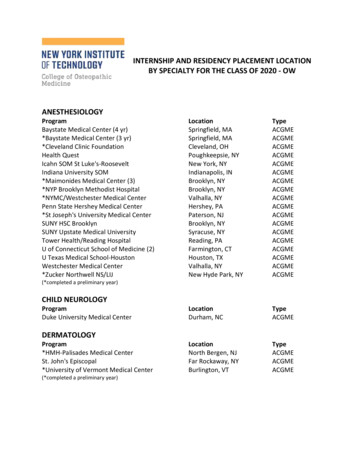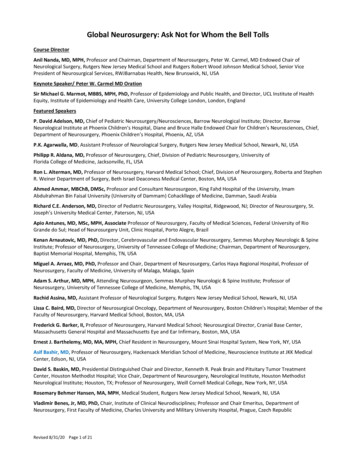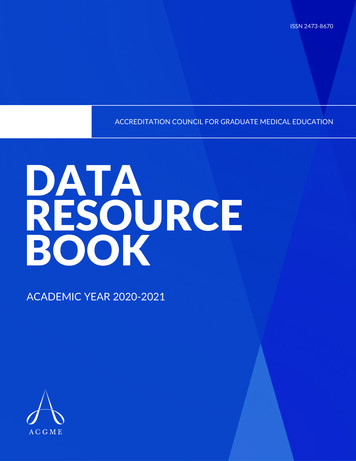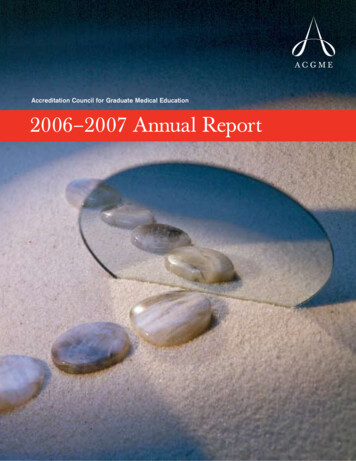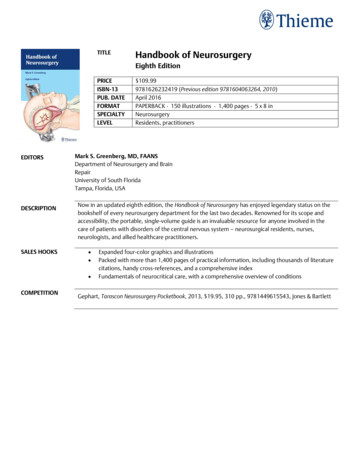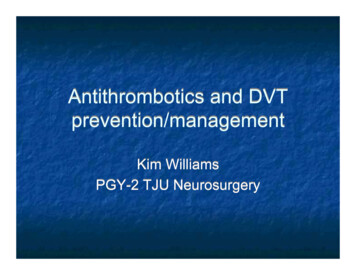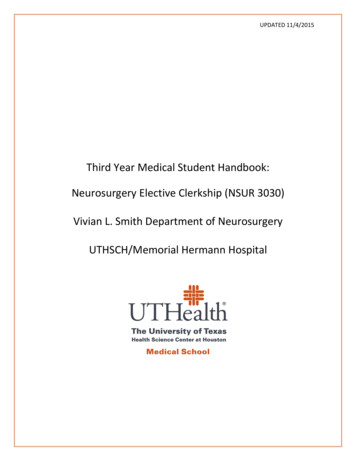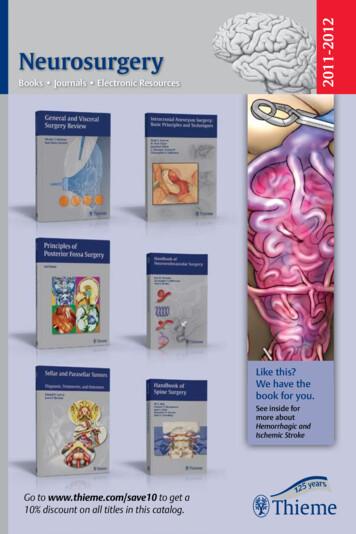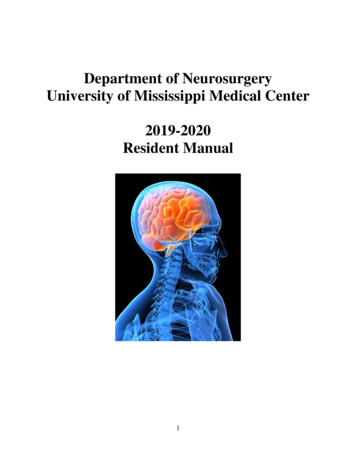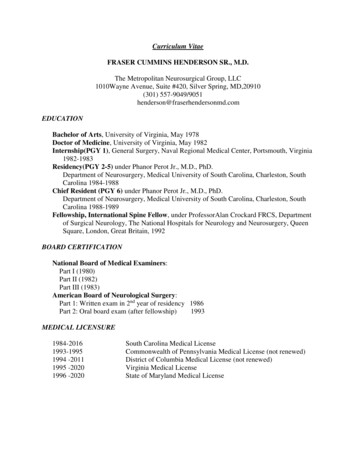
Transcription
Accreditation Council for Graduate Medical EducationNeurosurgery Program DirectorWorkshopH. Hunt Batjer, MDChair, Neurological Surgery Review Committee, ACGMEPamela L. Derstine, PhD, MHPEExecutive Director Neurological Surgery Review Committee, ACGMENathan R. Selden, MD, PhDProgram Director, OHSUCongress of Neurological SurgeonsOctober 6, 2012
Disclosures Hunt Batjer – no financial disclosures Pamela Derstine – no financial disclosuresfull-time employee ACGME Nathan Selden – no financial disclosures
Workshop OverviewDidactics [1-2 pm] The Next AccreditationSystem Assessment Basics MilestonesClinical CompetencyCommittees (CCC) pt 1 Clinical CompetencyCommittee Demonstration[2-2:45 pm]BREAK [2:45-3:15]Clinical CompetencyCommittees (CCC) pt 2 Clinical CompetencySmall Group Practice[3:15-4 pm]Small Group Debriefand Discussion [4-5 pm]
Next Accreditation System Goals Reduce the burden of accreditation Free good programs to innovate Assist poor programs to improve Realize the promise of Outcomes Provide public accountability for outcomes 2012 Accreditation Council for Graduate Medical Education (ACGME)
NAS in a Nutshell Continuous Accreditation Model Based on review of annually submitted data SVs replaced by 10-year Self-Study Visit Standards revised every 10 years Standards organized by Core Processes Detailed Processes Outcomes 2012 Accreditation Council for Graduate Medical Education (ACGME)
Conceptual change from The Current Accreditation SystemRulesRulesCorresponding QuestionsCorresponding Questions“Correct or Incorrect”Answer“Correct or Incorrect”AnswerCitations and AccreditationDecisionCitation and AccreditationDecision 2012 Accreditation Council for Graduate Medical Education (ACGME)
To.The Next Accreditation SystemContinuousObservationsPromote PotentialProblemsInnovationEnsure ProgramFixes the ProblemDiagnosethe Problem(if there is one) 2012 Accreditation Council for Graduate Medical Education (ACGME)
Conceptual Model of Standards ImplementationAcross the Continuum of Programs in a SpecialtyAccreditationWith MajorConcernsApplicationforNew ProgramAccreditationwith tion10-15%2-4%75-80%STANDARDSCore ProcessDetail ProcessOutcomesOutcomesCore ProcessDetail ProcessOutcomesCore ProcessDetail ProcessOutcomesCore ProcessDetail ProcessWithdrawal of Accreditation 1% 2012 Accreditation Council forGraduate Medical Education (ACGME)
Trended Performance Indicators Annual ADS Update Program Attrition – Changes in PD/Core Faculty/Residents Program Characteristics – Structure and Resources Scholarly Activity – Faculty and Residents Board Pass Rate – Rolling Rates Resident Survey – Common and Specialty Elements Faculty Survey – Core Faculty (Nov-Dec. 2012 phase 1 only)* Clinical Experience – Case Logs or other Semi-Annual Resident Evaluation and Feedback Milestones (first reports December 2013 phase 1 only)* New 2012 Accreditation Council for Graduate Medical Education (ACGME)
Performance AbilityThe Goal of the Continuum ofClinical Professional DevelopmentUndergraduateMedical Education 2012 Accreditation Council for Graduate Medical Education (ACGME)Graduate MedicalEducationClinicalPractice
The “GME Envelope of Expectations”AKA - entAspirationalGoalsPerformance AbilityEnteringPGY-1 2012 Accreditation Council forGraduate Medical Education (ACGME)
The Continuum of Clinical Professional Development:Authority and Decision Making versus sidencyPGY-1 yearSub-internshipClerkshipPhysical DiagnosisLow“Graded or ProgressiveResponsibility”Authority and Decision Making 2012 Accreditation Council for Graduate Medical Education (ACGME)High
The Continuum of Professional DevelopmentThe Three Roles of the Physician1ClinicianTeacherManager of ResourcesDevelopmentHighLowPhysical Dx Clerkship Sub-Internship PGY-1Residency Fellowship AttendingAs conceptualized and described by Gonnella, J.S., et. al.Assessment Measures in Medical Education, Residency and Practice. 155-173.Springer, New York, NY. 1993, and in 1998 Paper commissioned by ABMS. 2012 Accreditation Council for Descriptively graphed by Nasca, T.J.1Graduate Medical Education (ACGME)
Professional Development in thePreparation of the NeurosurgeonPerformance AbilitySystems-Based Practice, OR Team SkillsSurgery Related Technical SkillsPatient Care, Non-ProceduralPGY 1PGY 2PGY 3 2012 Accreditation Council for Graduate Medical Education (ACGME)PGY 4 PGY 7MOC
Milestones Observable steps on continuum of increasing ability Intuitively known by experienced specialty educators Organized under six domains of clinical competency Describe trajectory from neophyte to practitioner Articulate shared understanding of expectations Set aspirational goals of excellence Provide framework & language to describe progress 2012 Accreditation Council for Graduate Medical Education (ACGME)
ACGME Goal for Milestones Permits fruition of the promise of “Outcomes” Tracks what is important Begins using existing tools for faculty observations Clinical Competence Committee triangulatesprogress of each resident Essential for valid and reliable clinical evaluation system ACGME RCs track unidentified individuals’ trajectories ABMS Board may track the identified individual 2012 Accreditation Council for Graduate Medical Education (ACGME)
ACGME Goal for Milestones Specialty specific normative data Common expectations for individual resident progress Development of specialty specific evaluation tools 2012 Accreditation Council for Graduate Medical Education (ACGME)
Move from Numbers to Narratives Numerical systems produce range restriction Narratives: easily discerned by faculty shown to produce data without range restriction11 Hodgesand othersMost recent reference: Regehr, et al. Using “Standardized Narratives” toExplore New Ways to Represent Faculty Opinions of Resident Performance.Academic Medicine. 2012. 87(4); 419-427. 2012 Accreditation Council for Graduate Medical Education (ACGME)
The “Envelope of Expectations”Professionalism:Accepts responsibility and follows through on tasksPerformance atingResidentAspirationalGoalsResident effectively managesmultiple competing tasks, andeffortlessly manages complexcircumstances.Is clearly identifiedResident always prioritizesand willinglyby peers andsubordinates asworks on multiple competingcomplexof guidanceand routine cases insourcea timelymanner byand support indifficultor unfamiliarcircumstances.directly providing patientcareor byResident frequently prioritizes multipleoverseeing it. In difficult circumstancescompeting demands and completes theappropriately seeks guidance. Isvast majority of his/her responsibilities inregularly sought out by peers anda timely manner. Self identifiessubordinates to provide them guidance.circumstancesand activelyResident routinelycompletesmost seeksguidanceunfamiliarcircumstances.assigned tasksin a intimelymannerinaccordance with local practice and/orstill requires guidance inResident completespolicy,many butassignedunfamiliarcircumstances.tasks on time but needsextensiveguidance on local practice and/orpolicy for patient care. 2012 Accreditation Council forGraduate Medical Education (ACGME)
Assessing Milestones
NAS Timeline for NS Training phase has begun (7/2012) RRC reviews all data for all programs at spring 2013meeting (includes 2012 surveys, annual ADS updateinfo, case log reports): will not ‘count’ RRC determines benchmarks for follow-up actions(e.g., progress report, focused site visit, etc.) Traditional program reviews and non-accreditationrequests reviewed as usual (January and June 2013RRC meetings) Programs establish process for use of milestonereporting tools (Clinical Competency Committees) Enter NAS 7/2013 First Self-study visits July 2014 2012 Accreditation Council forGraduate Medical Education (ACGME)
Milestone Advisory Group Dan Barrow - ABNS Past Chair Hunt Batjer - RRC Chair Kim Burchiel - SNS President Elect, RRCVice-Chair Ralph Dacey - SNS President Arthur Day - SNS Past President Fred Meyer - ABNS Secretary, RRC ExOfficio 2012 Accreditation Council for Graduate Medical Education (ACGME)
Milestone Implementation Group Nathan Selden (Chair): CommonCompetencies (IPCS, Prof, PBLI, SBP) Aviva Abosch: Functional Richard Byrne: Tumor & Epilepsy Robert Harbaugh: Trauma & Critical Care William Krause: Spine Timothy Mapstone: Pediatrics Oren Sagher: Pain & Peripheral Nerve Gregory Zipfel: Vascular 2012 Accreditation Council forGraduate Medical Education (ACGME)
NS Milestone Domains Brain Tumor (PC/MK) Critical Care (PC/MK) Pain and Peripheral Nerve(PC/MK) Pediatric Neurosurgery(PC/MK) Spinal Neurosurgery (PC) Spinal Neurosurgery:Degenerative Disease (MK) Spinal Neurosurgery:Trauma and Infection (MK) 2012 Accreditation Council for Graduate Medical Education (ACGME) Surgical Treatment ofEpilepsy and MovementDisorders (PC/MK) Traumatic Brain Injury (PC) Interpersonal andCommunications Practice-based Learning Professionalism Systems-based Practice
Milestones Milestone alpha Pilot: June – August 2012(28 programs) Program Director Feedback– Oct.-Nov. 2012(email comments to: ledgar@acgme.org) Milestone final drafts: published by12/31/2012What’s Next? Incorporating Milestones into yourassessment program 2012 Accreditation Council forGraduate Medical Education (ACGME)
1Miller’s Pyramid of Clinical CompetenceClinical Observations, Mini CEX,Multi-Source Feedback, Teamwork Evaluation,Does Operative (Procedural) Skill EvaluationShows HowKnows HowKnowsClinical Observation, Simulation,Standardized Patients, Mini CEXMCQ, Oral Examinations, StandardizedPatientsMCQ, Oral Examinations1Miller,GE. Assessment of Clinical Skills/Competence/Performance.Academic Medicine (Supplement) 1990. 65. (S63-S67)van der Vleuten, CPM, Schuwirth, LWT. Assessing professional competence:from Methods to Programmes. Medical Education 2005; 39: 309–317 2012 Accreditation Council forGraduate Medical Education (ACGME)
Key Elements of QualityEvaluation of Miller’s “Does” Trained Observers Common understanding of the expectations Sensitive “eye” to key elements Consistent evaluation of levels of performance Many Quality Observations Interpreter/Synthesizer Experts Clinical Competency Committee (ResidentEvaluation Committee) 2012 Accreditation Council for Graduate Medical Education (ACGME)
Basics of*Assessment Competence is specific, not generic Content specificity is the dominantsource of unreliability regardless ofmethod Objectivity does not equal reliability Sampling across other factors (e.g.,subjective judgments of assessors)improves reliability*CPM van der Vleuten, et al (2010) Best Practice &Research Clinical Obstetrics and Gynecology 24: 703-719 2012 Accreditation Council forGraduate Medical Education (ACGME)
Basics of*Assessment What is being measured is determined more by theformat of the stimulus than the format of theresponse Authenticity is essential Validity can be ‘built-in’ Control and optimize materials, prepare stakeholders,standardize administration, utilize psychometricprocedures for “knows” “shows” and “shows how” Built-in validity is different at the ‘does’ level of Miller’spyramid 2012 Accreditation Council for Graduate Medical Education (ACGME)
Basics ofDoes*AssessmentStimulus format: habitual practice performanceResponse format: direct observation, checklists,rating scales, narrativesShows HowStimulus format: hands-on (patient) standardizedscenario or simulationResponse format: direct observation, checklists,rating scalesKnows HowStimulus format:(patient) scenario, simulationResponse format: menu, written, open ,oral, computer-basedKnowsStimulus format: fact orientedResponse format: menu, written,open, computer-based, oral 2012 Accreditation Council for Graduate Medical Education (ACGME)
Basics of*Assessment No single method can do it all Any single method is confined to onelevel of Miller’s pyramid Any method can have utility Bias is an inherent characteristic ofexpert judgment 2012 Accreditation Council for Graduate Medical Education (ACGME)
Basics of*AssessmentThe bottom line: Strive towards assessment in authenticsituations Utilize broad sampling perspective tocounterbalance unstandardized andsubjective nature of judgments 2012 Accreditation Council for Graduate Medical Education (ACGME)
Assessing “Does” Relies on information from knowledgeablepeople to judge performance Stimulus format is the authentic context(unstandardized and unstructured) Response format is generic (not tailored tospecific context) – global ratings with oralfeedback; written comments Sample across clinical contexts andassessors to overcome subjectivity ofindividual assessments 2012 Accreditation Council forGraduate Medical Education (ACGME)
Assessing “Does”Two types of assessment instruments Direct performance measures Observation of single concrete situation (e.g., OPR;direct encounter card); repeated across encountersand assessors Exposure to learner over time (e.g., peer assessment,MSF, single expert/mentor global assessment) Aggregation Methods In-depth, multiple competency domains, longitudinal Logbook or portfolio (may include case details,complications, approaches, outcomes; projectdocuments; publications [drafts/final]; etc.) 2012 Accreditation Council for Graduate Medical Education (ACGME)
Assessing “Does” A feasible sample is required to achieve reliableinferences 8-10 irrespective of instrument or what is beingmeasured Bias is an inherent characteristic of expertjudgment relieve assessor of potentially compromising, multipleroles; use multiple assessors Validity resides more in the users of theinstruments than in the instruments that are used standardizing trivializes the assessment 2012 Accreditation Council for Graduate Medical Education (ACGME)
Assessing “Does” Formative and summative functions are typicallycombined if a learner sees no value in an assessment, itbecomes trivial Successful feedback is conditional on socialinteraction coaching, mentoring, discussing portfolios, mediationaround multisource feedback Qualitative, narrative information carries a lot ofweight richer and more appreciated than quantitative 2012 Accreditation Council for Graduate Medical Education (ACGME)information
Assessing “Does” Achieve rigor in summative decisions withnon-psychometric qualitative research procedures Prolonged engagementTriangulationPeer examinationMember checkingStructural coherenceTime samplingThick descriptionStepwise replicationAudit 2012 Accreditation Council for Graduate Medical Education essen et al (2005) Medical Education 39: 214-220
Assessing “Does” Clinical Competency Committee Uses predefined criteria (i.e.,milestones) to make judgments moretransparent (audit) Members discuss milestones to achievecommon understanding (structuralcoherence) 2012 Accreditation Council for Graduate Medical Education (ACGME)
Assessing “Does” Clinical Competency Committee Receives input from mentor (prolongedengagement), many assessors anddifferent credible groups (time sampling,stepwise replication, triangulation) Incorporate narrative information indecisions (thick description) Incorporate learner’s point of view inassessment procedure (memberchecking) 2012 Accreditation Council forGraduate Medical Education (ACGME)
Assessing “Does” Clinical Competency Committee Discusses inconsistencies inassessment data (structural coherence) Document assessment steps; provideopportunity for appeal (audit) Difficult decisions require more time,input, consultations (until ‘saturation’) 2012 Accreditation Council for Graduate Medical Education (ACGME)
Neurosurgery MilestonesNathan R. Selden, MD, PhDCampagna Chair of Pediatric NeurosurgeryResidency Program Director
Milestones - Key features Minimal standards of experience by detailedcase categories Objective and reproducible, consensusassessments of key milestones within everycompetency– Clinical Competency Committee– Development of additional assessment tools Developmental progression across training– Extends to practice: ‘Lifelong Learning’
Matrix vs. ls) Objective Lumbar PunctureVentriculostomyCSF SampleShunt tapTractionStereotactic frameplacementTeachingMethods AANS/SNSOn‐linemodules Conferences Supervisedlearning BootcampAssessmentTools Faculty cient(4)The “Matrix” is a comprehensive curriculum for neurological surgeryReflects RRC case categories and ABNS written examinationquestion content categoriesSNS CoRE, Curriculum Subcommittee (Chair: Tim Mapstone)
Matrix vs. Milestones The Milestones are a reporting tool for the developmental stage ofindividual residents with regards to skills, knowledge and attitudesCreated by all specialties as part of ACGME reform initiative
Assessment vs. Reporting Assessments: Specific tools to objectivelyevaluate knowledge and skills– Some we have: ABNS written examination, SANS 360 degree evaluations Clinical/operative observation & proctoring– Some we may adopt: OSCI (objective structured clinical interview) Surgical skill simulator assessment Milestones: Reporting instrument
Milestones Group: Principles Synthesizing PD & Advisory Group Input– Economize One page per milestone Fewer milestones– Milestones are representative biopsies, notcomprehensive curricula– Individual competencies should be repeated acrosslevels consistent with development– Milestones should be systematically organized acrosssubspecialty– Stick with the core
Milestones Drafts Available here today– 20 one page milestones– Medical Knowledge and Patient Care forsubspecialties (including Critical Care)– ‘General’ Competencies: Professionalism,Communications, PBL, SBP
Neurosurgery Milestones Specialty based––––––––Tumor: MK & PCFunctional & Epilepsy: MK & PCVascular Neurosurgery: MK & PCPain & Peripheral Nerve: MK & PCPediatrics: MK & PCCritical Care: MK & PCTBI: PCSpine: MK, MK & PC
Neurosurgery Milestones General––––ProfessionalismInterpersonal Skills & CommunicationPractice-based learningSystems-based practice Total– 20 milestones– 20 pages
Dreyfus tic InventoryNoviceBeginner MSIV‐PGY1CompetenceEarly Learner PGY1‐2ProficiencyCompetent PGY2‐6ExpertiseProficient – PGY7MasteryExpert – Fellow/Staff1980s2000s
Early Learner Demonstrates competence occasionally; usually shows ability tolearn in routine, repetitive or non‐stressful situations Requires supervisionCompetent Demonstrates competence under routine circumstances Can perform without supervision in predictable circumstances Recognizes limitations and accesses support when needed
Proficient Demonstrates competence under most circumstances throughintuition and analytical thought processes in unpredictablesituations Is consistently trusted to deal effectively with complex problemsExpert Demonstrates competence through understanding the conceptualwhole with adaptability to the circumstance Can recognize errors or inadequacies in knowledge, judgment, skills Is a persuasive lifelong learner Is a resource mentor, teacher, and role model in this area.
Progression (Not Grade)NoviceBeginner MSIV‐PGY1CompetenceEarly Learner PGY1‐2ProficiencyCompetent PGY2‐6ExpertiseProficient – PGY7MasteryExpert – Fellow/Staff1980s2000s
Milestones Scoring Goals– Objective– Reproducible– Transparent to public and stakeholders– Enforceable (only competent residentsadvance) Method– Clinical competency committee (CCC)
CCC Clinical Competency Committee– Six to eight senior faculty– Includes Program Director, Chair– Represents core subspecialties– Meets every six months to reviewassessments (in resident portfolio) anddetermine milestone levels– Works by consensus
Resident Promotion Determined by– Initially: Comparison to peers in program– Eventually: Comparison to national specialtybenchmarks Tempo of individual resident development– Can vary within limits Endpoint for safe independent practice– Does not vary– Proficiency in the core competencies of the specialtyas identified by the milestones is required
Resident Promotion Failure to progress– Remediation or Probation Assign mentorRequire additional readings, SANS, testingAssign skills lab and/or simulator practiceAdd or modify rotations– Repurposing to another specialty orseparation from the training program
Program Evaluation Milestones progress by residents will be used aspart of program quality evaluation andaccreditation Why not ‘game the system’?– Milestones are biopsies of the broader field ofneurosurgery: don’t ‘train to the test’– Milestones performance on key areas of the specialtyassess the preparedness of the individual forunsupervised practice: this is our duty to safety andthe excellence of neurosurgery
PD Concerns Faculty Burden– Time One CCC meeting every 6 months Combine with Residency Advisory Committee function Milestones will inform and improve program quality– Benefits Subspecialty milestones representation is mark of seniority,engagement with residency Formal educational role for faculty P&T file Ability to influence resident development and progress Price of entry for teaching and clinical supervision
PD Concerns How to develop new assessments? Most assessments are already in place The Society of Neurological Surgeons will help Share individual program ideas and accomplishmentsvia the Program Director Toolkit (www.societyns.org) Accomplish core formal assessments in groups– PGY1 Boot Camp (introductory emergency & technical skills)– Junior Resident Course (NEW in 2013)» Breaking bad news» Structured clinical evaluations» Surgical simulation
PD Concerns How to develop new assessments? SNS Neurosurgical Portal– Comprehensive online learning tool– Embodies SNS Matrix Curriculum»»»»Didactic material: Radiology, Pathology, AnatomyOperative videosLectures: SNS-AANS Modules, CNS UniversityFocused assessment: SANS– Linked to relevant Milestones criteria– Automatic reporting to PDs
PD Concerns Will milestones affect length of training forindividual residents (lengthen or shorten)?– Not envisioned immediately– Any proposed change to length of individual’straining period would need prospectiveconsideration by the ABNS
PD Concerns No pediatric attending on site – how do we completePediatrics MK & PC milestones?– PD should collaborate with pediatric rotation director Important areas of my subspecialty are not represented– Milestones are an assessment reporting tool, not a curriculum(think ‘biopsy’) How are we doing compared to other surgicalspecialties?– Neurosurgery milestones have been refined in multiple stepsand are more carefully consolidated and edited than most– We are one of 7 early adopter specialties for July 1, 2013
PD Concerns Discoverability– Discoverable according to existing state and federallaws for education and employment, no change Liability– Milestones data may be used for non-promotion orseparation decisions– Properly employed, milestones improve the statusquo: Created in specialty wide consultative process Implemented correctly, reflect transparent consensus ofmultiple expert faculty with access to formative data
Timeline Spring 2013 – Form a CCC and preparefor milestones evaluations July – December 2013 First evaluationperiod December 2013 First milestonesevaluations submitted to ACGME (viaweb)
Thanks Allan Friedman – Chair, Working GroupHunt Batjer – Chair, RRCRalph Dacey – President, SNSKim Burchiel – President-elect, SNSNick Barbaro – Secretary, SNSTim Mapstone – Chair, SNS CurriculumSubCom Pam Derstine – ED, Neurosurgery RRC Laura Edgar – Milestones Project, ACGME Heidi Waldo – Program Coordinator, OHSU
Program Director, OHSU Congress of Neurological Surgeons October 6, 2012. Disclosures Hunt Batjer - no financial disclosures Pamela Derstine - no financial disclosures full-time employee ACGME . Academic Medicine (Supplem ent) 1990. 65. (S63-S67) Key Elements of Quality
